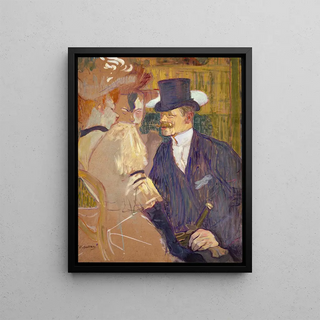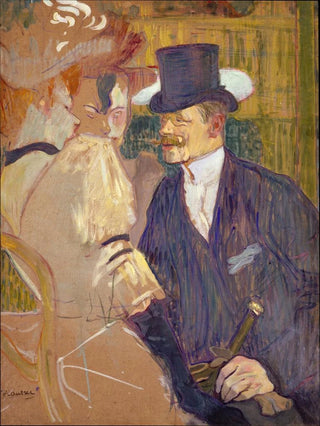Art print | William Tom Warrener 1861-1934 at the Moulin Rouge - Henri de Toulouse-Lautrec


View from behind

Frame (optional)
In the vibrant universe of the Belle Époque, Henri de Toulouse-Lautrec's art asserts itself with unmatched strength, capturing the very essence of Parisian pleasures. His iconic work, "L'Anglais William Tom Warrener 1861-1934 at the Moulin Rouge," stands out for its ability to transcend mere portraiture to become a true ode to nightlife. This painting, evoking the famous Moulin Rouge cabaret, invites viewers to immerse themselves in a world where dance, music, and conviviality blend in fascinating harmony. The art print of this emblematic piece allows for rediscovering the electric atmosphere of that era, while paying tribute to one of the most influential artists of his time.
Style and uniqueness of the work
Toulouse-Lautrec's style is characterized by a bold color palette and a dynamic composition that reflect the energy of Parisian life. In "L'Anglais William Tom Warrener," the artist uses flowing lines and stylized forms to depict his subject with palpable emotional intensity. The central figure, William Tom Warrener, is captured in a moment of grace, with delicately sketched features, while the vibrant background evokes the tumult of the Moulin Rouge shows. The way Toulouse-Lautrec plays with light and shadow enhances the festive character of the work, transporting the viewer to the heart of this sensory experience. This painting does not merely depict a scene of entertainment; it also immortalizes the spirit of an era where art and life intertwine, offering a reflection on Parisian society at the end of the 19th century.
The artist and his influence
Henri de Toulouse-Lautrec, born in 1864, managed to capture the essence of his time through his art. Coming from an aristocratic family, he quickly diverged from conventions to embrace the bohemian life of Montmartre. His work reflects not only his exceptional talent but also his commitment to representing society's marginalized figures, such as artists, dancers, and prostitutes. Toulouse-Lautrec knew how to give a

Matte finish

View from behind

Frame (optional)
In the vibrant universe of the Belle Époque, Henri de Toulouse-Lautrec's art asserts itself with unmatched strength, capturing the very essence of Parisian pleasures. His iconic work, "L'Anglais William Tom Warrener 1861-1934 at the Moulin Rouge," stands out for its ability to transcend mere portraiture to become a true ode to nightlife. This painting, evoking the famous Moulin Rouge cabaret, invites viewers to immerse themselves in a world where dance, music, and conviviality blend in fascinating harmony. The art print of this emblematic piece allows for rediscovering the electric atmosphere of that era, while paying tribute to one of the most influential artists of his time.
Style and uniqueness of the work
Toulouse-Lautrec's style is characterized by a bold color palette and a dynamic composition that reflect the energy of Parisian life. In "L'Anglais William Tom Warrener," the artist uses flowing lines and stylized forms to depict his subject with palpable emotional intensity. The central figure, William Tom Warrener, is captured in a moment of grace, with delicately sketched features, while the vibrant background evokes the tumult of the Moulin Rouge shows. The way Toulouse-Lautrec plays with light and shadow enhances the festive character of the work, transporting the viewer to the heart of this sensory experience. This painting does not merely depict a scene of entertainment; it also immortalizes the spirit of an era where art and life intertwine, offering a reflection on Parisian society at the end of the 19th century.
The artist and his influence
Henri de Toulouse-Lautrec, born in 1864, managed to capture the essence of his time through his art. Coming from an aristocratic family, he quickly diverged from conventions to embrace the bohemian life of Montmartre. His work reflects not only his exceptional talent but also his commitment to representing society's marginalized figures, such as artists, dancers, and prostitutes. Toulouse-Lautrec knew how to give a






